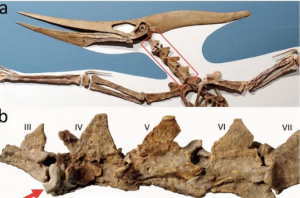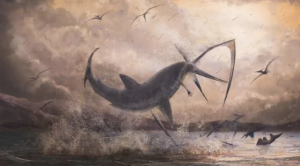More than 80 million years ago, a winged reptile called a pteranodon bobbed placidly on the waves of the Western Interior Seaway, which ran straight through what is today North America. Suddenly, the water below the flying reptile erupted into froth, teeth and sharkskin. When the chaos cleared, the pteranodon was dead and a monster of a shark was missing a tooth.
That’s the picture painted by a new paper published online Dec. 14 in the journal PeerJ about a curious fossil: a partial skeleton of a Late Cretaceous pteranodon with a nearly 1-inch-long (24 millimeters) shark tooth embedded in its neck.

Granted, the researchers wrote, the story could be a bit more mundane. Perhaps the shark simply scavenged the floating carcass of an already-dead pteranodon. Either way, the fossil is a rare record of the sea and the sky meeting in the time of the dinosaurs.
“We’ve got good direct evidence that a good-sized shark took a chunk out of a big flying reptile over 80 million years ago,” said study co-author Michael Habib, a paleontologist at the University of Southern California’s Keck School of Medicine. “It’s pretty cool.”
The fossil with the tooth embedded is on public display at the Natural History Museum of Los Angeles County, but it was found in Kansas in 1965. In the Late Cretaceous, what is today Kansas was under the shallow Western Interior Seaway, which covered much of the center of North America. The species of pteranodon in this find is unknown, but it likely lived between about 86 million and 83 million years ago. It was a big animal, with a wingspan about 16.4 feet (5 meters) across.
more at livescience.com
Ask me anything
Explore related questions





